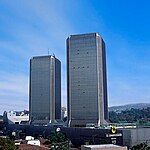Agua Caliente, Tijuana

Agua Caliente is a historic entertainment center and present-day district of Tijuana, Baja California, at the southeastern end of the Centro borough. The Agua Caliente Tourist Complex formed in the late 1920s along Agua Caliente Boulevard when a road was built that led from the historic Rio Zone to a natural hot springs two miles up the Tijuana River Valley. Paramount icons of Tijuana developed in Agua Caliente such as the Agua Caliente Casino and Hotel and the Agua Caliente Racetrack. Today Agua Caliente is one of Tijuana's paramount tourist centers, the location of some of the city's most affluent neighborhoods, and also contains commercial and other offices along Boulevard Agus Caliente.
Excerpt from the Wikipedia article Agua Caliente, Tijuana (License: CC BY-SA 3.0, Authors, Images).Agua Caliente, Tijuana
Boulevard Agua Caliente, Tijuana
Geographical coordinates (GPS) Address Nearby Places Show on map
Geographical coordinates (GPS)
| Latitude | Longitude |
|---|---|
| N 32.509444444444 ° | E -116.99305555556 ° |
Address
Boulevard Agua Caliente (Boulevard Gustavo Salinas)
Boulevard Agua Caliente
22100 Tijuana
Baja California, Mexico
Open on Google Maps






